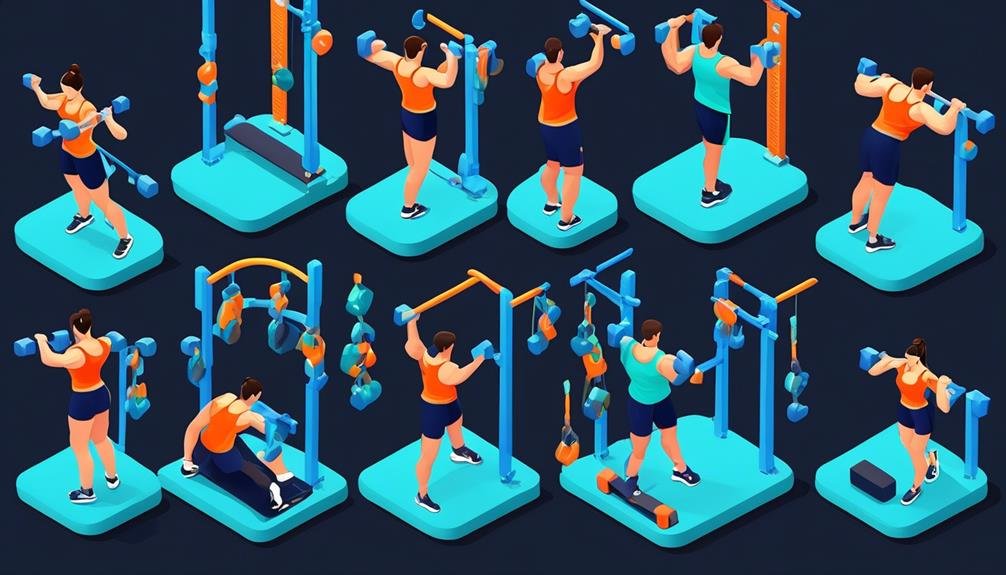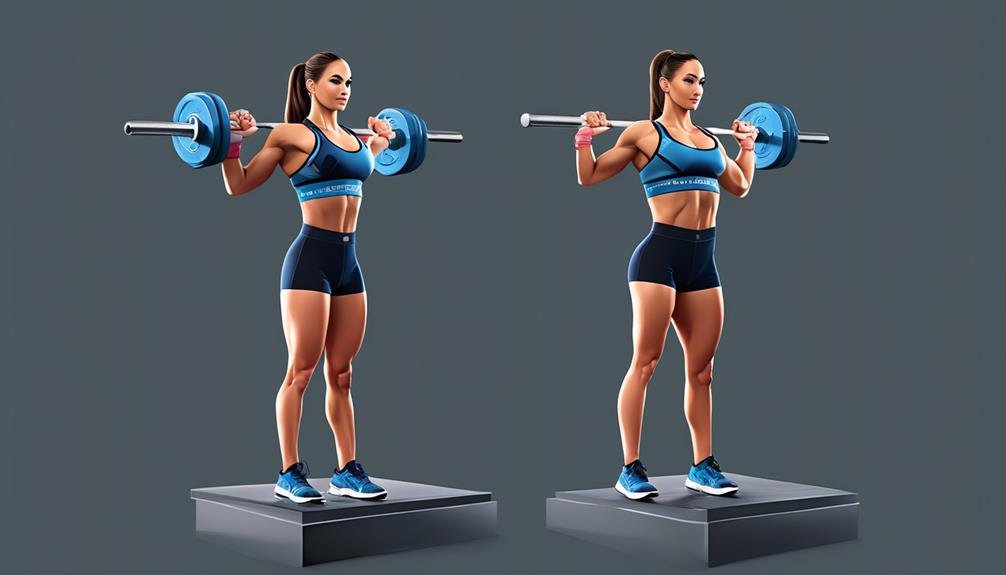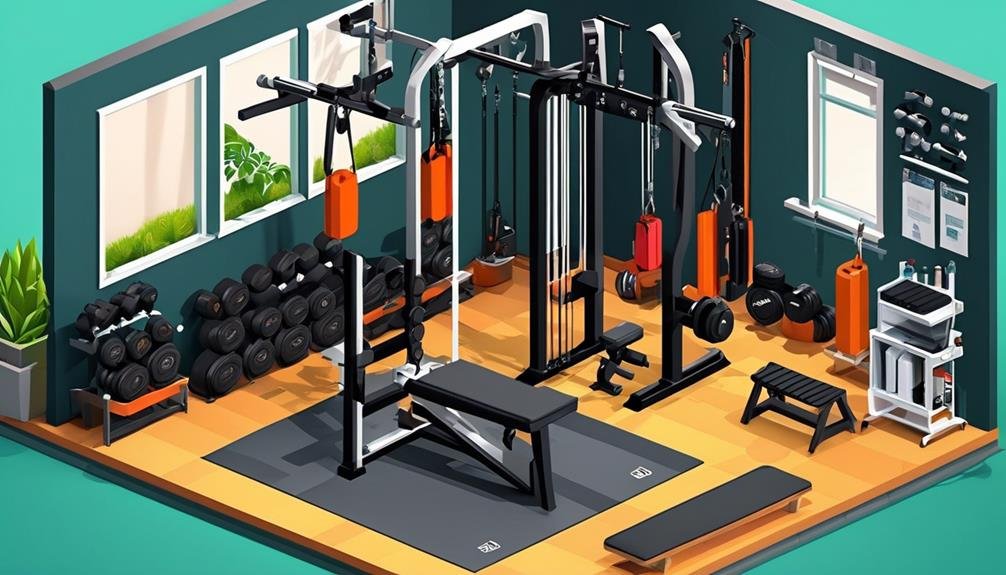When it comes to lifting weights alone at home, taking the necessary safety precautions is crucial.
Imagine this scenario: you're in the middle of an intense workout session, pushing your limits, when suddenly you feel a sharp pain in your lower back. You realize that you've strained a muscle, and now you're left wondering how you could have avoided this mishap.
Well, fear not! In this discussion, we will explore a range of safety tips that will help you prevent injuries and ensure a safe and effective weightlifting experience in the comfort of your own home.
So, let's dive in and discover the key steps you should take to protect yourself while pursuing your fitness goals.
Key Takeaways
- Choose a suitable location for your home gym and ensure it is free from safety hazards.
- Inspect equipment for damages and securely store weights when not in use.
- Wear proper footwear and attire for stability and invest in quality workout clothing.
- Warm up before lifting, start with lighter weights, and prioritize exercises that prioritize safety.
Setting Up Your Home Gym
To start setting up your home gym, choose a suitable location in your house with enough open space to move around freely and avoid any obstacles. This is crucial for your safety and to ensure that you have enough room to perform different exercises with weights and other equipment. When selecting the space, consider the size and weight of the equipment you plan to use. Make sure there's ample space to accommodate weight plates and other accessories without feeling cramped.
In addition to the physical space, it's important to consider safety features in your home gym. For instance, having a mirror can be helpful for resistance training as it allows you to monitor your form and prevent injuries. Also, make sure the area is clear of any safety hazards like throw rugs or wobbly artwork, which can cause accidents.
Don't forget to check the ceiling height as well, especially if you plan to do any overhead movements or jumping activities. You don't want to accidentally hit the ceiling or any light fixtures.
Lastly, equip your home gym with safety essentials such as a towel to wipe up sweat, shoes with good traction to prevent slipping, and a cell phone nearby in case of emergencies. While it's always recommended to have a personal trainer guide you through your workouts, following these safety tips will help ensure a safe and effective workout in the comfort of your own home.
Proper Equipment and Gear
Investing in the proper equipment and gear is essential for a safe and effective workout when lifting weights alone at home. Here are three important safety tips to keep in mind regarding your equipment and gear:
- Choose appropriate shoes: When lifting weights, it's crucial to wear shoes with good traction to prevent slipping or sliding. Look for shoes specifically designed for weightlifting or cross-training, as they provide stability and support during your workouts. This will help you maintain proper form and avoid accidents or injuries.
- Check your equipment condition: Before starting your workout, make sure that all your equipment is in good condition. Inspect your dumbbells, barbells, or any other weightlifting equipment for any signs of wear and tear. Loose or damaged equipment can be hazardous, so it's important to address any issues before using them. Replace or repair any damaged equipment to ensure your safety.
- Wear quality workout clothing: Opt for workout clothing that allows for unrestricted movement during your exercises. Choose breathable fabrics that wick away sweat, keeping you comfortable and cool throughout your workout. Proper attire not only enhances your performance but also minimizes the risk of clothing getting caught on equipment or hindering your range of motion.
Preparing Your Body for Lifting

Now that you have ensured your equipment and gear are in good condition, it's time to focus on preparing your body for the lifting session ahead. Properly preparing your body is crucial to avoid injury and get the most out of your workout.
One of the first steps in preparing your body for lifting is to warm up. Start by engaging in stretching exercises and calisthenics to loosen up your muscles. This will help increase your flexibility and range of motion, reducing the risk of strains and tears.
Dynamic stretches are great for warming up before active workouts. These involve moving parts of your body through a full range of motion, such as arm circles or leg swings. On the other hand, static stretches are perfect for cooling down after your workout. They involve holding a stretch for a certain period of time, allowing your muscles to relax and recover.
When starting your lifting session, it's important to start with lighter weights and gradually progress. This allows your body to adapt and build strength without overwhelming it. Avoid jumping straight into lifting heavy weights, as this can lead to poor form and potential injury.
Additionally, it's crucial to prioritize exercises that prioritize safety. Avoid attempting extremely challenging exercises alone for the first time. Exercises like the clean and jerk, which involve lifting a barbell from the ground to overhead in one motion, should be approached with caution and preferably with a spotter.
Lifting Techniques and Form
Proper lifting techniques and form are essential for maximizing your workout results and minimizing the risk of injury. When lifting weights alone at home, it's crucial that you pay attention to your technique and form to ensure a safe and effective workout.
Here are three key tips to help you lift weights correctly:
- Wear shoes: Always wear proper athletic shoes when lifting weights. This will provide stability and support for your feet, reducing the risk of slipping or losing your balance.
- Use the right equipment: Make sure you have the appropriate equipment for your workout. For example, if you're doing bench presses, use a sturdy and stable bench that can support the weight you're lifting. Using the wrong equipment or using it incorrectly can increase the risk of injury.
- Focus on technique, not just weight: It's tempting to push yourself and lift heavy weights, but it's important to prioritize proper technique over the amount of weight you lift. Whether you're performing Olympic lifts or training to failure, ensure that each movement is performed correctly to avoid strain or injury.
Safety Measures During and After Lifting

To ensure your safety during and after lifting weights alone at home, it's important to implement a few key measures. Your safety should always be the top priority when working out, so let me explain some safety measures you can take to protect yourself.
First and foremost, warming up before exercising and cooling down afterward is crucial. This helps prevent injuries and aids in your recovery. Spend a few minutes doing some light cardio and dynamic stretches to prepare your body for the workout. After you're done, dedicate some time to static stretching to help your muscles relax and recover.
Another important safety measure is to keep your cell phone nearby. In case of emergencies or accidents, having your phone within reach can be a lifesaver. You never know when you might need to call for help, so make it a habit to have your phone nearby during your workout sessions.
Monitoring your form is also driven by safety. Using a mirror during resistance training exercises can help ensure you're performing the movements correctly and prevent injuries. Proper form is essential for maximizing the effectiveness of your workouts and minimizing the risk of strains or sprains.
When it comes to clothing, wearing quality workout attire that allows unrestricted movement is essential. Opt for breathable fabrics that provide comfort and support. Additionally, make sure to wear proper footwear that offers traction and stability. This will help prevent slips or falls during your workouts.
If possible, consider using a power cage or squat rack with safeties. These equipment options provide an added layer of safety when lifting alone. They can catch the barbell if you're unable to complete a rep, reducing the risk of injury.
Lastly, it's important to listen to your body and know your limits. Don't push yourself too hard, especially when lifting weights alone. Start with less weight and gradually increase as you become more comfortable and confident. Always prioritize safety over lifting heavy.
Frequently Asked Questions
How to Safely Lift Weights Alone?
To safely lift weights alone, follow these tips: warm up before lifting, use proper form to avoid injury, start with lighter weights and gradually increase, listen to your body, take breaks, and don't forget to stretch afterwards.
What Safety Practices Should You Follow When Lifting Weights?
When lifting weights alone at home, it's important to prioritize safety. Follow these tips to minimize the risk of injury: warm up properly, use proper form, start with lighter weights, and listen to your body.
What Are 3 of the Safety Concerns That Arise When Lifting Weights?
When lifting weights alone at home, it's important to prioritize safety. Three key concerns include using proper form to avoid injury, not lifting too much weight beyond your capabilities, and having a backup plan in case of accidents.
What Are 5 Guidelines to Follow in the Weight Room?
When in the weight room, it's important to follow these 5 guidelines: keep your back straight, use proper lifting technique, wear shoes with good traction, check equipment condition, and have a cell phone nearby for emergencies.
Conclusion
In conclusion, when lifting weights alone at home, it's crucial to prioritize safety. By setting up a proper home gym, using the right equipment and gear, and preparing your body for lifting, you can greatly minimize the risk of injuries.
Remember to maintain proper lifting techniques and form, and always follow safety measures during and after lifting. By following these safety tips, you can enjoy a safe and effective workout in the comfort of your own home.
Stay safe and keep lifting!





